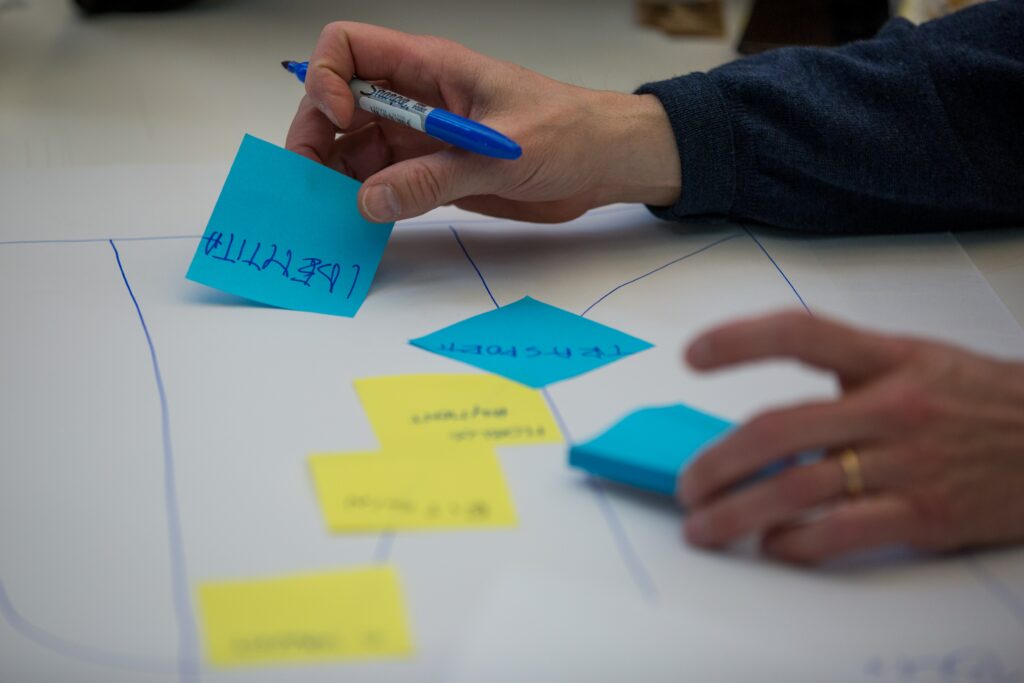This article is the first in a series of articles about our experience with Lean Inception. Be sure to check out our other posts.
Lean Inception is the combination of Design Thinking and Lean StartUp to decide the Minimum Viable Product (MVP). It is “a workshop divided into several steps and activities that will guide the team in building the ideal product” (Lean Inception, caroli.org/en/livro/lean-inception-how-to-align-people-and-build-the-right-product/). It is the creation of Paulo Caroli, a software engineer who wanted to find a way to condense a four-week inception program run by Thoughtworks. What he produced was a methodology, which included a series of activities executed over one week that allows a team to set the direction and scope of a product at the outset.
In the years since its creation, the Lean Inception methodology has undergone various modifications, including adapting in-person exercises to a Miro template for remote teams. More details about the process of Lean Inception can be found at Paulo Caroli’s website.
At Foci, we have been running Lean Inception for our own internal R&D product to improve our overall understanding of the Lean Inception process—and ultimately using this process to help our clients through better product development, and help our readers with their own application of Lean Inception by sharing our experiences.

Core Concepts
The Lean Startup
Before Lean Inception, there was The Lean Startup by Eric Ries. In The Lean Startup, Ries describes the Build–Measure–Learn methodology. This methodology assumes your products are validated frequently during development with actual customers, enabling you to understand what holds the most value for them and, ultimately, what will best meet their needs. Caroli designed Lean Inception to find the first increment that could be built in an effective Measure and Learn cycle.
MVP
For Caroli, this first increment was the Minimum Viable Product (MVP). MVP has become a loaded term in software development (as we’ll discuss in our future posts), but Caroli seeks to emphasize that an MVP should be developed only just enough to allow you to test your product hypothesis.
He uses the example of EasyTaxi, a Brazilian business that allows users to request taxis online. To verify if people would actually use such a service, the original application was a simple webpage that would send an email to the EasyTaxi founder at the user’s request, at which point the founder would call a taxi for the user. While very rudimentary, it demonstrated to the founders that their project was in demand and had the potential to become a viable product.
Caroli emphasizes that the MVP is not a complete layer (like building all your infrastructure first, for example); he describes it as a cupcake—instead of a complete cake with icing (the UX ‘wow factor’), it has been scaled down to a manageable size. This approach is also commonly referred to as a ‘vertical slice’, referencing slicing a cake through all its layers, top to bottom, rather than one layer at a time. As we will see, these core concepts are essential to the success of Lean Inception activities. There are many times when Lean Inception can easily get sidetracked, at which point returning to these core concepts can help realign the work.
What is Involved?
Over a period of one week, our team went through a series of activities that established the following:
- Product vision
- What the product does and does not do
- Initial product goals
- Personas
- Prioritization of product goals by persona
- User journeys
- Feature brainstorming
- Initial technical, business, and UX review of features
- Sequence and iterations for features to be delivered as part of the MVP.
Why We Did It
As consultants, we have experience working through tough challenges across multiple and varied projects. Clients often assign a series of requirements or tasks to engineering teams; however, these teams will struggle to deliver the right product when they cannot answer basic product questions:
- What are the vision and goals for the product?
- What are the stakeholder expectations behind these requirements?
- What kind of users are you targeting?
Many clients have difficulty documenting these answers and even those who do document their work often do not share it with the teams building the product. According to Asana, the “2021 Anatomy of Work Index, which surveyed over 10,000 knowledge workers, found that less than half of all employees understood how their day-to-day work contributed to broader goals.” (Why Projects Fail).
At Foci, when we first heard of Lean Inception, we saw it as an opportunity to coach our clients through some of the most important discovery processes in a project lifecycle. Lean Inception would ensure that their whole team has a clear shared understanding and vision of the product, resulting in more collaboration, less conflict, and greater value earlier in product delivery.
What’s Next?
Stay tuned for our following blog posts. There we will explain our own experience running Lean Inception on an internal project as well as some lessons we learned and suggestions on how you can improve your first Lean Inception.